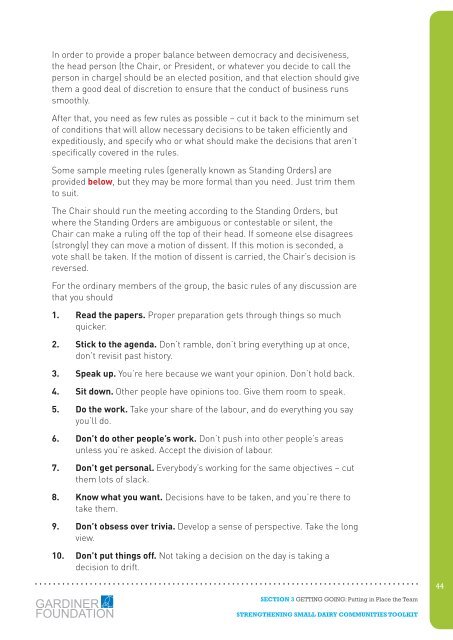The Complete Toolkit - Gardiner Foundation
The Complete Toolkit - Gardiner Foundation
The Complete Toolkit - Gardiner Foundation
You also want an ePaper? Increase the reach of your titles
YUMPU automatically turns print PDFs into web optimized ePapers that Google loves.
In order to provide a proper balance between democracy and decisiveness,<br />
the head person (the Chair, or President, or whatever you decide to call the<br />
person in charge) should be an elected position, and that election should give<br />
them a good deal of discretion to ensure that the conduct of business runs<br />
smoothly.<br />
After that, you need as few rules as possible – cut it back to the minimum set<br />
of conditions that will allow necessary decisions to be taken efficiently and<br />
expeditiously, and specify who or what should make the decisions that aren’t<br />
specifically covered in the rules.<br />
Some sample meeting rules (generally known as Standing Orders) are<br />
provided below, but they may be more formal than you need. Just trim them<br />
to suit.<br />
<strong>The</strong> Chair should run the meeting according to the Standing Orders, but<br />
where the Standing Orders are ambiguous or contestable or silent, the<br />
Chair can make a ruling off the top of their head. If someone else disagrees<br />
(strongly) they can move a motion of dissent. If this motion is seconded, a<br />
vote shall be taken. If the motion of dissent is carried, the Chair’s decision is<br />
reversed.<br />
For the ordinary members of the group, the basic rules of any discussion are<br />
that you should<br />
1. Read the papers. Proper preparation gets through things so much<br />
quicker.<br />
2. Stick to the agenda. Don’t ramble, don’t bring everything up at once,<br />
don’t revisit past history.<br />
3. Speak up. You’re here because we want your opinion. Don’t hold back.<br />
4. Sit down. Other people have opinions too. Give them room to speak.<br />
5. Do the work. Take your share of the labour, and do everything you say<br />
you’ll do.<br />
6. Don’t do other people’s work. Don’t push into other people’s areas<br />
unless you’re asked. Accept the division of labour.<br />
7. Don’t get personal. Everybody’s working for the same objectives – cut<br />
them lots of slack.<br />
8. Know what you want. Decisions have to be taken, and you’re there to<br />
take them.<br />
9. Don’t obsess over trivia. Develop a sense of perspective. Take the long<br />
view.<br />
10. Don’t put things off. Not taking a decision on the day is taking a<br />
decision to drift.<br />
44<br />
SECTION 3 GETTING GOING: Putting in Place the Team<br />
STRENGTHENING SMALL DAIRY COMMUNITIES TOOLKIT




